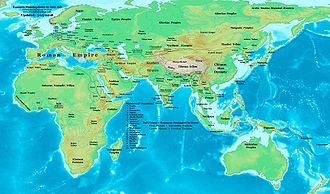This article needs additional citations for verification .(March 2019) |



| Millennia |
|---|
| 1st millennium |
| Centuries |
| Timelines |
| State leaders |
| Decades |
| Categories: |
| Births – Deaths Establishments – Disestablishments |
The 3rd century was the period from AD 201 (represented by the Roman numerals CCI) to AD 300 (CCC) in accordance with the Julian calendar.
Contents
In this century, the Roman Empire saw a crisis, starting with the assassination of the Roman Emperor Severus Alexander in 235, plunging the empire into a period of economic troubles, barbarian incursions, political upheavals, civil wars, and the split of the Roman Empire through the Gallic Empire in the west and the Palmyrene Empire in the east, which all together threatened to destroy the Roman Empire in its entirety, but the reconquests of the seceded territories by Emperor Aurelian and the stabilization period under Emperor Diocletian due to the administrative strengthening of the empire caused an end to the crisis by 284. This crisis would also mark the beginning of Late Antiquity. While in North Africa, Roman rule continued with growing Christian influence, particularly in the region of Carthage.
In Persia, the Parthian Empire was succeeded by the Sassanid Empire in 224 after Ardashir I defeated and killed Artabanus V during the Battle of Hormozdgan. The Sassanids then went on to subjugate many of the western portions of the declining Kushan Empire. In Africa the most significant event was the rise of the Aksumite Empire in what is now Ethiopia, which experienced significant military expansion and became a major trading hub in northeast Africa. [1]
In China, the chaos that had been raging since 189 would ultimately continue to persist with the decisive defeat of Cao Cao at the Battle of Red Cliffs in 208, which would increasingly end the hopes of unification and lead to the tripartite division of China into three main empires; Shu, Wu, and Wei, colloquially known as the Three Kingdoms period, which started in 220 with the formal abdication of Emperor Xian of Han to Cao Cao's son, Cao Pi, thereby founding Wei, which would go on to conquer Shu in 263, but would ultimately be united again under the Jin dynasty, headed by the Sima clan, who would usurp Wei in 266, and conquer Wu in 280.
In other parts of the world, Korea was ruled by the Three Kingdoms of Korea, Japan entered the Kofun period and the Southeast Asian mainland was mostly dominated by Funan, the first kingdom of the Khmer people. In India, the Gupta Empire was on the rise towards the end of the century. In Pre-Columbian America, the Adena culture of the Ohio River valley declined in favor of the Hopewell culture. The Maya civilization entered its Classic Era.


